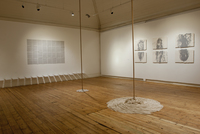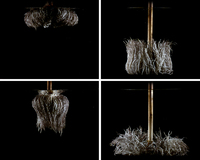Items
Site
The Medicine Chest
keywords is exactly
dust
-

Kimberley, South Africa: miners and washing gear at the Bultfontein diamond mine
Woodburytype -

Griqualand West, South Africa: Kimberley diamond mine.
Woodburytype -

Kimberley Mine
A detail from the wallpaper used outside the Cape Town Diamond Museum in the V&A Waterfront. -

Kimberley Mine 1886
Plate from Williams, G. 1902. 'The Diamond Mines of South Africa: Some Account of their Rise and Development'. New York, London: Macmillan. -

The body fluid
"We shed many skin cells – at a rate per hour it comes close to a million cells per day. New cells generated at the bottom of our layered epidermis push their way to the top, where they are weathered by the environment and our daily activities. As the living body breaks down, it becomes lodged in skin pores and clothing fibres. It is inhaled, irritates, is sneezed out and blown afar; it collects in corners, and gathers on surfaces. It welcomes company, joining with soil or, lifted by weather patterns, combines with volcanic eruptions, pollution and plant pollen, or with animal bodies, minerals, and even with burnt meteorite particles – all the while becoming increasingly microscopic and indistinct. The body, now fluid and divisible, transgresses boundaries. Transformed and nomadic, it inhabits spaces without detection. That is, until a ray of sunlight reveals drifting motes hovering in the air, or a missing shoe leads to the surprise discovery of a copulating fluffle of dust bunnies under the bed. In Gutspeak, these former remnants of ourselves are gathered by the artist Dominique Edwards from the tools used to seemingly eliminate them, and turned into sheets of paper. On closer inspection, these sheets reveal a multitude of its separate components: eyelashes, cosmetics, grains of sand, diminished chewing gum wrappers and pubic hair. There is also glitter. And a surprising amount of it. Are these cosmetic ingredients? Or...perhaps meteorite particles?" -

The Tide Turns Installation
Tumble dryer lint -

The Tide Turns Installation
Paper works made from new mops, used mops and tumble dryer lint. Sculptural installation consisting of one small intermittently rotating mop and one large continuously rotating mop. -

Mop
Videos projected onto a floating screen -

Floor
Used mop paper -

175 chalk-board dusters
For the exhibition, 'Curiosity CLXXV', the curators took an old duster from each teaching venue and replaced it with a new one. -

Einstein's abstracts
Cibachrome on aluminium. Microscopic magnification of Einstein’s equations from a blackboard that had been preserved in the History of Science Museum in Oxford -

Pompei casts
-

Silicosis
A gold miner using a rock drill with a water spray in an attempt to prevent the occupational disease silicosis, caused by dust inhalation. -

How to look at the night sky
"Even fainter is the galactic light, a diffuse glow that scatters off the dust in the space between the stars. It is said to account for an additional 6 percent of the light of the night sky, too faint to be distinguished from the integrated starlight and the nightglow. Dust accounts for another of these nighttime lights, the zodiacal light. It is caused by the zodiacal cloud, the name astronomers give to the dust that orbits the sun along with the planets and asteroids. Sunlight that reflects off the zodiacal cloud is called zodiacal light" (Elkins 2000: 214 - 215). -

Donahue near-miss
An artwork purchased in 2015 from the Michaelis School of Fine Art Graduate Show, created by then student, Tess Metcalf.


